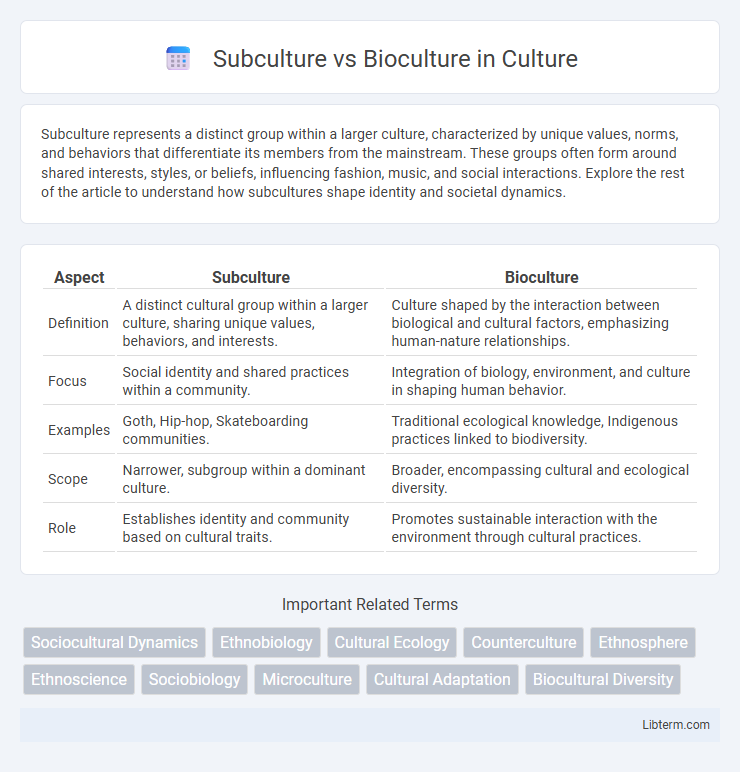Subculture represents a distinct group within a larger culture, characterized by unique values, norms, and behaviors that differentiate its members from the mainstream. These groups often form around shared interests, styles, or beliefs, influencing fashion, music, and social interactions. Explore the rest of the article to understand how subcultures shape identity and societal dynamics.
Table of Comparison
| Aspect | Subculture | Bioculture |
|---|---|---|
| Definition | A distinct cultural group within a larger culture, sharing unique values, behaviors, and interests. | Culture shaped by the interaction between biological and cultural factors, emphasizing human-nature relationships. |
| Focus | Social identity and shared practices within a community. | Integration of biology, environment, and culture in shaping human behavior. |
| Examples | Goth, Hip-hop, Skateboarding communities. | Traditional ecological knowledge, Indigenous practices linked to biodiversity. |
| Scope | Narrower, subgroup within a dominant culture. | Broader, encompassing cultural and ecological diversity. |
| Role | Establishes identity and community based on cultural traits. | Promotes sustainable interaction with the environment through cultural practices. |
Understanding Subculture: Definition and Key Traits
Subculture refers to a group within a larger culture that differentiates itself through distinctive values, norms, and behaviors, often based on shared interests, lifestyles, or identities. Key traits of subcultures include unique language, fashion, slang, and rituals that serve as markers of group identity and cohesion. Understanding subcultures involves analyzing these characteristics to explore how members create meaning and resist or complement dominant cultural norms.
Defining Bioculture: Concepts and Foundations
Bioculture integrates biological and cultural factors to explore how human biology and cultural practices influence each other within environmental contexts. Unlike subculture, which refers to distinct cultural groups within a larger society, bioculture emphasizes the interconnectedness of genetic, ecological, and social elements shaping human behavior and identity. Key foundations of bioculture include the study of co-evolution, environmental adaptation, and the role of traditional knowledge in sustaining both biological diversity and cultural heritage.
Historical Evolution of Subculture and Bioculture
The historical evolution of subculture reflects diverse social groups emerging within dominant cultures, often as responses to industrialization, urbanization, and globalization since the 20th century. Bioculture's evolution intertwines with the rise of biotechnology and environmental movements, emphasizing the relationship between biological life and cultural practices since the late 20th century. Subcultures primarily develop through shared values, symbols, and resistance, while bioculture integrates scientific knowledge and ecological awareness into cultural identity and community practices.
Core Differences Between Subculture and Bioculture
Subculture refers to a group within a larger culture that differentiates itself through unique values, norms, and behaviors, often shaped by social, ethnic, or regional factors. Bioculture emphasizes the interaction between biology and culture, exploring how genetic traits and cultural practices co-evolve and influence human diversity. Core differences lie in subculture's focus on social identity and cultural expression, while bioculture integrates biological inheritance with cultural development to understand human adaptation.
The Role of Identity in Shaping Subculture
Identity plays a central role in shaping subcultures by providing members with a sense of belonging and distinctiveness from the mainstream culture. Subcultures often emerge through shared values, symbols, and practices that reinforce group identity, creating a collective self-awareness and cultural expression. Unlike bioculture, which integrates biological and cultural aspects of human life, subculture emphasizes social identity and symbolic meanings that define group boundaries and individual roles within the community.
Biocultural Influences on Human Behavior
Bioculture integrates genetic, ecological, and cultural factors to shape human behavior, emphasizing the dynamic interaction between biology and culture. Unlike subculture, which focuses on distinct groups within a larger society, biocultural influences highlight how evolutionary adaptations and cultural practices co-evolve, influencing cognition, health, and social patterns. Research in biocultural anthropology reveals how environmental pressures and cultural norms jointly impact behaviors such as dietary choices, stress responses, and social bonding.
How Subcultures Impact Society and Innovation
Subcultures drive societal evolution by fostering unique identities and challenging mainstream norms, resulting in increased diversity and social innovation. They act as incubators for creativity, influencing art, technology, and lifestyle trends that eventually permeate wider culture. The dynamic interaction between subcultures and dominant culture accelerates innovation and reshapes social values.
Intersections: Where Subculture Meets Bioculture
Subculture and bioculture intersect in the ways that human groups express identity through both social practices and biological heritage, blending cultural traits with genetic and environmental influences. These intersections reveal how subcultures adapt and evolve by incorporating biocultural factors such as diet, health, and reproductive behaviors, which are shaped by cultural beliefs and ecological contexts. Understanding this fusion enhances insights into human diversity, emphasizing the dynamic relationship between cultural norms and biological adaptation.
Challenges and Misconceptions in Studying Cultures
Challenges in studying subcultures and biocultures include difficulty in accurately defining boundaries due to overlapping traits and evolving identities. Misconceptions arise from the assumption that subcultures are purely social constructs, while biocultures integrate genetic, ecological, and cultural factors in complex ways. Researchers must navigate these nuances to avoid oversimplification and ensure a comprehensive understanding of cultural dynamics.
Future Perspectives: Integrating Subculture and Bioculture
Future perspectives in integrating subculture and bioculture focus on harnessing cultural diversity alongside biological heritage to promote sustainable development and resilience. Advances in biotechnology and anthropological research enable the creation of hybrid frameworks that respect traditional knowledge while fostering innovation in health, agriculture, and environmental management. These integrative approaches aim to support community empowerment, biodiversity conservation, and adaptive strategies in response to global challenges like climate change and social inequality.
Subculture Infographic

 libterm.com
libterm.com